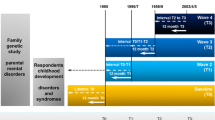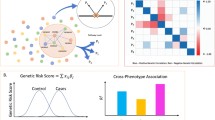Abstract
The development of prevention and treatment strategies of psychiatric disorders will depend on a more profound knowledge of the complex relationships between gene-environment interactions, particularly the interplay of vulnerability and resilience factors within a person’s biography. In this article, the advantages and limitations of the current psychiatric classification systems will be discussed. New directions for a future multiaxial system including biological, psychological, social, life span, gender and cultural factors based on the DSM-V- and ICD-11-research agenda are going to be outlined. Psychiatry without psychopathology is impossible. However, in the future, psychopathology will be closer linked to the biological and psychological nature of the disease process and more function-based. Future diagnostic classification manuals should include dimensional and categorical aspects as well as vulnerability and resilience diagnostic elements. There is a need for a personalized integrative diagnosis and care.
Similar content being viewed by others
References
Almeida D (2005) Resilience and vulnerability to daily stressors assessed via dairy methods. Curr Dir Psychol Sci 14:64–68
Altemus M (2007) Neurobiology and sex/gender. In: Narrow W, First M, Sirovatka P, Regier D (eds) Age and gender considerations in psychiatric diagnosis. Am Psychiatric Association, Arlington, pp 47–63
American Psychiatric Association (1994) Diagnostic and statistical manual of mental disorders, 4th edn, DSM-IV-TM. Am Psychiatric Association, Washington, pp XV–XXV
Angst J (2007) The bipolar spectrum. Br J Psychiatry 190:189–191
Antonovsky A (1996) The salutogenic model as a theory to guide health promotion. Health Promot Int 11:453–470
Bennett AJ (2008) Gene environment interplay: nonhuman primate models in the study of resilience and vulnerability. Dev Psychobiol 50:48–59
Canli T, Lesch K (2007) Long story short: the serotonin transporter in emotion regulation and social cognition. Nat Neurosci 10:1103–1109
Charney D, Barlow D, Botteron K et al (2002) Neuroscience research agenda to guide development of a pathophysiologically based classification system. In: Kupfer D, First M, Regier D (eds) Research agenda for DSM-V. American Psychiatric Association, Washington, pp 31–83
Cicchetti D, Blender JA (2006) A multiple-levels-of-analysis perspective on resilience: implications for the developing brain, neural plasticity and preventive interventions. Ann NY Acad Sci 1094:248–258
Daud A, Skoglund E, Rydelins P (2005) Children in families of torture victims. Transgenerational transmission of parents traumatic experiences to their children. Int J Soc Welfare 14:23–32
Daud A, Klinteberg B, Rydelius P (2008) Resilience and vulnerability among refugee children of traumatized and non-traumatized parents. Child Adolesc Psychiatr Mental Health 2:7. doi:10.1186/1753-2000-2-7
De Quervain D, Kolassa I, Ertl V, Onyut P, Neuner F, Elbert T, Papassotiropoulos A (2007) A deletion variant of the α2b-adrenoceptor is related to emotional memory in Europeans and Africans. Nat Neurosci. doi: 10.1038/nn 1945
De Rosse P, Funke B, Burdick K, Lencz T, Ekholm J, Kane J, Kucherlapati R, Malhotra A (2006) Dysbindin genotype and negative symptoms in schizophrenia. Am J Psychiatry 163:532–534
Gaebel W, Wölwer W, Zielasek J (2006) Von der deskriptiven zur funktionalen Psychopathologie: Auf dem Weg zu einer modularen Psychiatrie. Die Psychiatrie 3:221–232
Garmezy N, Masten A, Tellegen A (1984) The study of stress and competence in children: a building block for developmental psychopathology. Child Dev 55:97–111
Gotlib I, Joormann J, Minor K, Hallmayer J (2008) HPA axis reactivity: a mechanism underlying the associations among 5-HTTLPR, stress and depression. Biol Psychiatry 63:847–851
Grant B, Weissmann M (2007) Gender and the prevalence of psychiatric disorders. In: Narrow W, First M, Sirovatka P, Regier D (eds) Age and gender considerations in psychiatric diagnosis. Am Psychiatric Association, Arlington, pp 31–45
Greenwood T and the consortium on the genetics of schizophrenia (2007) Initial heritability analyses of endophenotypic measures of schizophrenia. Arch Gen Psychiatry 64 (11): 1242–1250
Heim C, Newport D, Heit S, Graham Y, Wilcox M, Bonsall R, Miller A, Nemeroff C (2000) Pituitary-adrenal and autonomic responses to stress in women after sexual and physical abuse in childhood. JAMA 284:592–597
Kendell R, Jablensky A (2003) Distinguishing between the validity and utility of psychiatric diagnoses. Am J Psychiatry 160:4–12
Kim J (2008) Serotonin, stress and conditioning. Biol Psychiatry 63:819–820
Klaassens E, van Veen T, Zitman F (2008) Does trauma cause lasting changes in HPA-axis functioning in healthy individuals. Prog Brain Res 167:273–275
Kobassa SC (1979) Stressful life events, personality and health: an inquiry into hardiness. J Pers Soc Psychol 37(1):1–11
McEwen B (2006) Protective and damaging effects of stress mediators: central role of the brain. Dialogues Clin Neurosci 8:367–381
Mezzich J, Salloum I (2008) Clinical complexity and person-centered integrative diagnosis. World Psychiatry 7:1–2
Mössner R, Mikova O, Koutsilieri E, Saoud M, Ehlis A, Müller N, Fallgatter A, Riederer P (2007) Consensus paper of the WFSBP task force on biological markers: biological markers in depression. World J Biol Psychiatry 8:141–174
Moore S, Zoellner L (2007) Overgeneral autobiographical memory and traumatic events: an evaluative review. Psychol Bull 133:419–437
Munafo M, Brown S, Hariri A (2008) Serotonin transporter (5-HTTLPR) genotype and amygdala activation: a meta-analysis. Biol Psychiatry 63:852–857
Olff M, de Vries G, Güzelcan Y, Assies J, Gersons B (2007) Changes in cortisol and DHEA levels after psychotherapy for PTSD. Psychoneuroendocrinology 32:619–626
Otto M, Henin A, Hirshfeld-Becker D, Pollack M, Biedermann J, Rosenbaum J (2007) Posttraumatic stress disorder symptoms following media exposure to tragic events: impact of 9/11 on children at risk for anxiety disorders. J Anxiety Disord 21:888–902
Pesonen A, Räikkönen K, Heinonen K, Andersson S, Hovi P, Järvenpää A, Eriksson J, Kajantie E (2008) Personality of young adults born prematurely: the Helsinki study of very low birth weight adults. J Child Psychol Psychiatry 49(6):609–617
Regier D, Sirovatka P, Rubio-Stipec M, Narrow W (2007) The future of psychiatric diagnosis: the APA/WHO/NIH research planning process for DSM and ICD. Die Psychiatrie 4:98–104
Rounsaville B, Alarcón R, Andrews G, Jackson J, Kendell R, Kendler K (2002) Basic nomenclature issues for DSM-V. In: Kupfer D, First M, Regier D (eds) Research agenda for DSM-V. American Psychiatric Association, Washington, pp 1–29
Rutter M, Pickles A, Murray R, Eaves L (2001) Testing hypotheses on specific environmental causal effects on behavior. Psychol Bull 127:291–324
Silver R, Kanichay R (2008) Neuroscience: refreshing connections. Science 320:183–184
Singer W (2005) How does the brain know when it is right? In: Changeux J, Damasio A, Singer W (eds) Neurobiology of human values. Springer Publ, Berlin, pp 125–135
Smoller J, Paulus M, Fagerness J, Purcell S, Yamaki L, Hirshfeld-Becker D, Biederman J, Rosenbaum J, Gelernter J, Stein M (2008) Influence of RGS2 on anxiety-related temperament, personality and brain function. Arch Gen Psychiatry 65(3):298–308
Stawski R, Sliwinski M, Almeida D, Smyth J (2008) Reported exposure and emotional reactivity to daily stressors: the roles of adult age and global perceived stress. Psychol Aging 23(1):52–61
Sterling P, Eyer J (1988) Allostasis: a new paradigm to explain arousal pathology. In: Fisher S, Reason J (eds) Handbook of life stress, cognition and health. Wiley, New York, pp 629–649
Tsankova N, Renthal W, Kumar A, Nestler E (2007) Epigenetic regulation in psychiatric disorders. Nat Neurosci 8:355–367
Van den Bergh B, van Calster B, Smits T van Huffel S, Lagae L (2007) Antenatal maternal anxiety is related to HPA-axis dysregulation and self-reported depressive symptoms in adolescence, a prospective study on the fetal origins of depressed mood. Neuropsychopharmacology: 1–10
Yehuda R, Teicher M, Seckl J, Grossmann R, Morris A, Bierer L (2007) Parental posttraumatic stress disorder as a vulnerability factor for low cortisol trait in offspring of Holocaust survivors. Arch Gen Psychiatry 64:1040–1048
Zobel A, Meier W (2004) Endophenotypes: a new concept for the biological characterization of mental disorders. Nervenarzt 75:205–214
Conflict of interest statement
The author has no conflict of interest with any commercial or other associations in connection with the submitted article.
Author information
Authors and Affiliations
Corresponding author
Rights and permissions
About this article
Cite this article
Müller-Spahn, F. Individualized preventive psychiatry: syndrome and vulnerability diagnostics. Eur Arch Psychiatry Clin Neurosci 258 (Suppl 5), 92–97 (2008). https://doi.org/10.1007/s00406-008-5020-4
Published:
Issue Date:
DOI: https://doi.org/10.1007/s00406-008-5020-4




